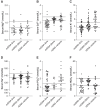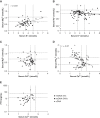Electrolyte Disorders in Mitochondrial Cytopathies: A Systematic Review
- PMID: 37678265
- PMCID: PMC10631606
- DOI: 10.1681/ASN.0000000000000224
Electrolyte Disorders in Mitochondrial Cytopathies: A Systematic Review
Abstract
Significance statement: Several recent studies identified mitochondrial mutations in patients with Gitelman or Fanconi syndrome. Mitochondrial cytopathies are generally not considered in the diagnostic workup of patients with electrolyte disorders. In this systematic review, we investigated the presence of electrolyte disorders in patients with mitochondrial cytopathies to determine the relevance of mitochondrial mutation screening in this population. Our analysis demonstrates that electrolyte disorders are commonly reported in mitochondrial cytopathies, often as presenting symptoms. Consequently, more clinical attention should be raised for mitochondrial disease as cause for disturbances in electrolyte homeostasis. Further prospective cohort studies are required to determine the exact prevalence of electrolyte disorders in mitochondrial cytopathies.
Background: Electrolyte reabsorption in the kidney has a high energy demand. Proximal and distal tubular epithelial cells have a high mitochondrial density for energy release. Recently, electrolyte disorders have been reported as the primary presentation of some mitochondrial cytopathies. However, the prevalence and the pathophysiology of electrolyte disturbances in mitochondrial disease are unknown. Therefore, we systematically investigated electrolyte disorders in patients with mitochondrial cytopathies.
Methods: We searched PubMed, Embase, and Google Scholar for articles on genetically confirmed mitochondrial disease in patients for whom at least one electrolyte is reported. Patients with a known second genetic anomaly were excluded. We evaluated 214 case series and reports (362 patients) as well as nine observational studies. Joanna Briggs Institute criteria were used to evaluate the quality of included studies.
Results: Of 362 reported patients, 289 had an electrolyte disorder, with it being the presenting or main symptom in 38 patients. The average number of different electrolyte abnormalities per patient ranged from 2.4 to 1.0, depending on genotype. Patients with mitochondrial DNA structural variants seemed most affected. Reported pathophysiologic mechanisms included renal tubulopathies and hormonal, gastrointestinal, and iatrogenic causes.
Conclusions: Mitochondrial diseases should be considered in the evaluation of unexplained electrolyte disorders. Furthermore, clinicians should be aware of electrolyte abnormalities in patients with mitochondrial disease.
Copyright © 2023 by the American Society of Nephrology.
Conflict of interest statement
R.J.M. Bindels reports Advisory or Leadership Role: REGMED XB Regenerative Medicine Crossing Borders; and Other Interests or Relationships: Scientific Board of the Dutch Kidney Foundation. J.H.F. de Baaij reports Other Interests or Relationships: Research funding from the Dutch Diabetes Research Foundation, the Dutch Kidney Foundation, the Dutch Organization of Scientific Research, and the European Union. J. Deinum reports Speakers Bureau: Health Investment and Prevents. L. Vermeltfoort reports Employer: House of Smart and Jeroen Bosch Ziekenhuis (boyfriend). The remaining author has nothing to disclose.
Figures





References
Publication types
MeSH terms
Substances
Supplementary concepts
LinkOut - more resources
Full Text Sources
Medical

